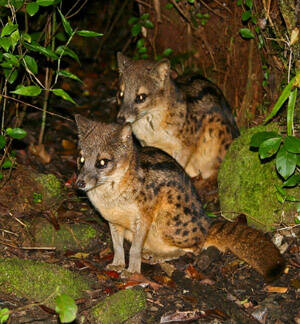
Civettictis civetta
Civettictis civetta
The African civet (scientific name: Civettictis civetta) is a civet in tropi···

Paguma larvata
Paguma larvata,Masked Palm Civet,Civet cat, white nose heart, hairy mouse, white eyebrow, five-faced civet cat, white nose dog, Qingjie, etc.
Paguma larvata (scientific name: Masked Palm Civet) is a carnivorous animal ···

Fossa fossana
Fossa fossana,Spotted Fanaloka,Malagasy civet, Malagasy civet, Malagasy civet
The Spotted Fanaloka (scientific name: Fossa fossana) is also called the Spo···

Eupleres goudotii
Eupleres goudotii,Small-toothed mongoose, sharp-nosed civet, anteater
The small-toothed mongoose (scientific name: Eupleres goudotii), also known ···

Cryptoprocta ferox
Cryptoprocta ferox,Fossa, Hidden Anal Civet, Hidden Spirit Cat
The mongoose (scientific name: Cryptoprocta ferox) is called Fossa in foreig···

Panthera onca
Panthera onca,Jaguar,Jaguar, jaguar
The scientific name of the jaguar is Panthera onca (Linnaeus, 1758), and its···

Panthera leo × tigris
Panthera leo × tigris,liger
Liger (scientific name: Panthera leo×tigris), also known as liger in Englis···

Golden Tiger
Golden Tiger,Strawberry Tiger
The golden tiger is a golden variant of the Bengal tiger. It is golden with ···

Pure White Tiger
Pure White Tiger
Pure white tigers, as the name suggests, are all white without any stripes. ···

Snow Tiger
Snow Tiger
The snow tiger is the result of further mutation of the white tiger gene, wi···

Bengal White Tiger
Bengal White Tiger,Bengal Tiger (white),Bengal white tiger, white tiger Bengal white tiger, white tiger
The albino Bengal tiger (English name: Bengal White Tiger) is also known as ···

Panthera tigris virgata
Panthera tigris virgata,Persian tiger, Xinjiang tiger, Caucasian tiger, Turan tiger, West Asian tiger, Central Asian tiger, Black Sea tiger
The Caspian tiger (Latin name: Panthera tigris virgata) is the third largest···

Panthera tigris tigris
Panthera tigris tigris,Bengal Tiger,Indian tiger, Bhutan tiger, Royal Bengal tiger
Bengal tiger (Panthera tigris tigris), also known as Bengal Tiger, is a nomi···

Panthera tigris ssp. sumatrae
Panthera tigris ssp. sumatrae,Sumatran Tiger
The Sumatran tiger (scientific name: Panthera tigris ssp. sumatrae), also kn···

Panthera tigris sondaica
Panthera tigris sondaica,Javan Tiger
The Javan tiger (Panthera tigris sondaica) is a species of tiger that once l···

Panthera tigris jacksoni
Panthera tigris jacksoni,Malayan Tiger,Malayan tiger, Malaysian tiger
The Malayan tiger (scientific name: Panthera tigris jacksoni) is the third s···

Panthera tigris corbetti
Panthera tigris corbetti,Indochinese tiger, Corbett tiger
The Indochinese tiger has the ability to camouflage itself in tall grass and···

Panthera tigris balica
Panthera tigris balica ,Bali Tiger
The scientific name of the Bali tiger is Panthera tigris balica (Schwarz, 19···

Panthera tigris amoyensis
Panthera tigris amoyensis ,south China tiger,Chinese tiger, South China tiger, Xiamen tiger,Amoyensis
The South China tiger (Latin name: Panthera tigris amoyensis) is a subspecie···

Panthera tigris ssp. altaica
Panthera tigris ssp. altaica, Amur Tiger、Altaic Tiger、Korean Tiger、North Chinese Tiger、Ussuri Tiger, Tigre de Sibérie,Tigr,Siberian tiger, Manchurian tiger, Korean tiger, Amur tiger
The Siberian tiger (scientific name: Panthera tigrisssp.altaica) is a subspe···

